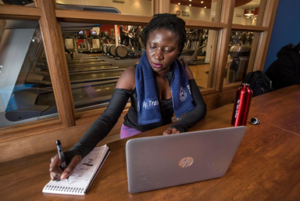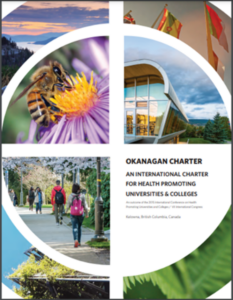
In this blog post, Kirstin Stuart James summarises the series and proposes five steps to envision the future of health and wellbeing in Higher Education by emphasizing a holistic consideration of teaching and learning occupations, transcending individual contexts, and being mindful of impacts on future generations of educators and learners. This post belongs to the Hot Topic series: Through the Lens of Occupation↗️.
The blog series ‘Through the Lens of Occupation↗️’ has set out a different way to look at health and Higher Education (HE) by drawing from the rich history of human occupation and its influences on occupational therapy and occupational science. Informed by this history, the series put forward how a pedagogy of occupation might make a different sense of issues in HE, especially those related to health and wellbeing, from a contextual, embodied, and human occupation-centred perspective.

The blog series has highlighted the close links between health and HE, and the ways in which the human occupations associated with teaching and learning can both promote and negatively impact human health and wellbeing (Figure 1). Specifically, the series looked at issues related to wellbeing and the occupations of teaching and learning, and potential impacts to health and wellbeing from HE, AI and climate change.
Pausing to step back for a moment, ‘health’ and ‘wellbeing’ have been applied frequently and interchangeably in the series, as is often the case elsewhere. Not least, this is also the case in the World Health Organisation’s (WHO) definition: “Health is a state of complete physical, mental and social well-being and not merely the absence of disease or infirmity” (WHO, 2022)↗️.
Linking to current research into the (health and) wellbeing of staff and students in HE- while not claiming to be a systematic review on the topic – reports show that, for example, ‘academic participants did not see easy ways of changing the political landscape and so their answers here tended to focus on their own organisation/systems or their own individual responses to the pressures they experienced’ (O’Brien and Guiney, 2018, p.14)↗️.
Similarly, a study by Brooker, McKague and Phillips (2019)↗️ in from New Zealand took a “whole of curriculum” (p. 56) approach to student wellbeing by embedding initiatives across the University curriculum. While the authors drew on dynamic systems theory, and recognised the broader contexts of universities, the focus remained on the individual in the individual context of the institution. Building on this work, a systematic review by Upsher et al (2022)↗️ concluded that there was limited quality evidence to confirm curriculum-based interventions are effective in supporting wellbeing, despite attention to curriculum design being among the commonest approaches to supporting student wellbeing (Upsher, et al, 2022)↗️.

It is interesting in the examples above, that wellbeing initiatives have focussed on interventions at the individual level in single institutions. In contrast, the seminal ‘Okanagan Charter’ (Figure 2), or the ‘International Charter for Health Promoting Universities and Colleges’ (Black and Stanton, 2016)↗️ clearly recognised the capacity of health promotion in, but more importantly across, universities to “transform current and future societies, strengthen communities and contribute to the well-being of people, places and the planet” (Black and Stanton, 2016, p2)↗️. The Charter’s socially-just conceptualisation of ‘health’ as situated, contextual and intergenerational has resonance with the pedagogy of occupation put forwards in the blog series.
Inspired by ‘Okanagan’, this final blog returns to Ekland et al’s tentative model (2017↗️, Figure 3) for the last time and below puts forward five steps to realise a future vision of health and wellbeing in HE, going beyond the individual in their singular institutional context, and instead considering both how occupations related to teaching and learning could be considered holistically to inform wellbeing approaches, while also being mindful of health and occupation impacts resultant from HE for future generations of teachers and learners.

Altogether, this builds to a future vision by taking the following steps:
Step 1: Occupational balance goes beyond the University.
The occupations involved in teaching and learning should be considered in ‘harmonic mix’ with occupations overall. Occupations that sit in balance across work/study, and opportunities for self-care and leisure occupations are health promoting.
Conversely, when occupations become out of balance, for example when work or study occupations are over-loaded, or when access to teaching and learning occupations are not available, both can detrimentally interfere with overall harmonic mix.
Step 2: Impacts within and impacts without
Linked to Step 1, from a teaching perspective considering occupational balance could be highlighted in, for example, personal development reviews to consider how work may be impactful beyond the institution. Similarly, for learning, for example student engagement requirements, should not be considered without understanding how engagement must sit in balance with other student occupational roles and responsibilities, including the occupations for self-care and leisure.
Step 3: Human health at the centre
Recognising that occupational balance has the potential to both positively and negatively impact health and wellbeing, learning and teaching design, and the environments in which it takes place should be centred in HE policy and practice from a health perspective.
Step 4: Interconnectedness of health, occupation, the place, its community and beyond
Higher Education does not take place in a vacuum. Impacts both positive and negative go beyond the individual and can ripple not only to their immediate social context, but further to their community and beyond.
Step 5: Eco-occupational justice for future teachers and learners
Ripples from the occupations related to teaching and learning can also impact (positively and negatively) intra- and intergenerationally which should also be a consideration in Higher Education policy and practice.
Bringing the blog series ‘Through the Lens of Occupation’ to a close, shining a light on the links between occupation, education and health has brought with it opportunity to consider how they can impact on each, other now and into the future. By centring the human-occupations related to teaching and learning through a pedagogy of occupation, it could realise a vision of HE positively linked to health and wellbeing now and into the future.
References
Black, T. and Stanton, A., 2016. Final Report on the Development of the Okanagan Charter: An International Charter for Health Promoting Universities & Colleges↗️.
Brooker, A., McKague, M. and Phillips, L., 2019. Implementing a whole-of-curriculum approach to student wellbeing↗️. Student Success, 10(3), pp.55-63.
Eklund, M., Orban, K., Argentzell, E., Bejerholm, U., Tjörnstrand, C., Erlandsson, L.K. and Håkansson, C. (2017). The linkage between patterns of daily occupations and occupational balance: Applications within occupational science and occupational therapy practice↗️. Scandinavian journal of occupational therapy, 24(1), pp.41-56.
O’Brien, T. and Guiney, D., 2018. Staff wellbeing in higher education↗️. Education Support Partnership.
Upsher, R., Nobili, A., Hughes, G. and Byrom, N., 2022. A systematic review of interventions embedded in curriculum to improve university student wellbeing↗️. Educational Research Review, 37, p.100464.
WHO, 2022. Achieving Well-being- A Global Framework for Integrating Well-being into Public Health. Available from: https://www.who.int/publications/m/item/wha-76—achieving-well-being–a-global-framework-for-integrating-well-being-into-public-health-utilizing-a-health-promotion-approach↗️ [Accessed: 06 February 2024].
 Kirstin Stuart James
Kirstin Stuart James
Dr Kirstin Stuart James is currently on secondment as Deputy Programme Director within the Clinical Sciences Teaching Organisation, part of the College of Medicine and Veterinary Medicine at University of Edinburgh. As her substantive post, Kirstin is Senior Academic Coordinator/MSc Year Lead in Clinical Education where she teaches on online distance learning programmes for those involved in undergraduate and postgraduate education across the health and veterinary professions. She is a Senior Fellow of the Higher Education Academy. Kirstin is also a Senior Occupational Therapist in Urgent and Emergency Care with NHS Lothian. Kirstin is interested in the links between health and education, and how an understanding of occupation and occupational therapy can enrich teaching, learning and educational design, and support health though education. You can find Kirstin on Twitter (X) at @TherapyStatim↗️.


